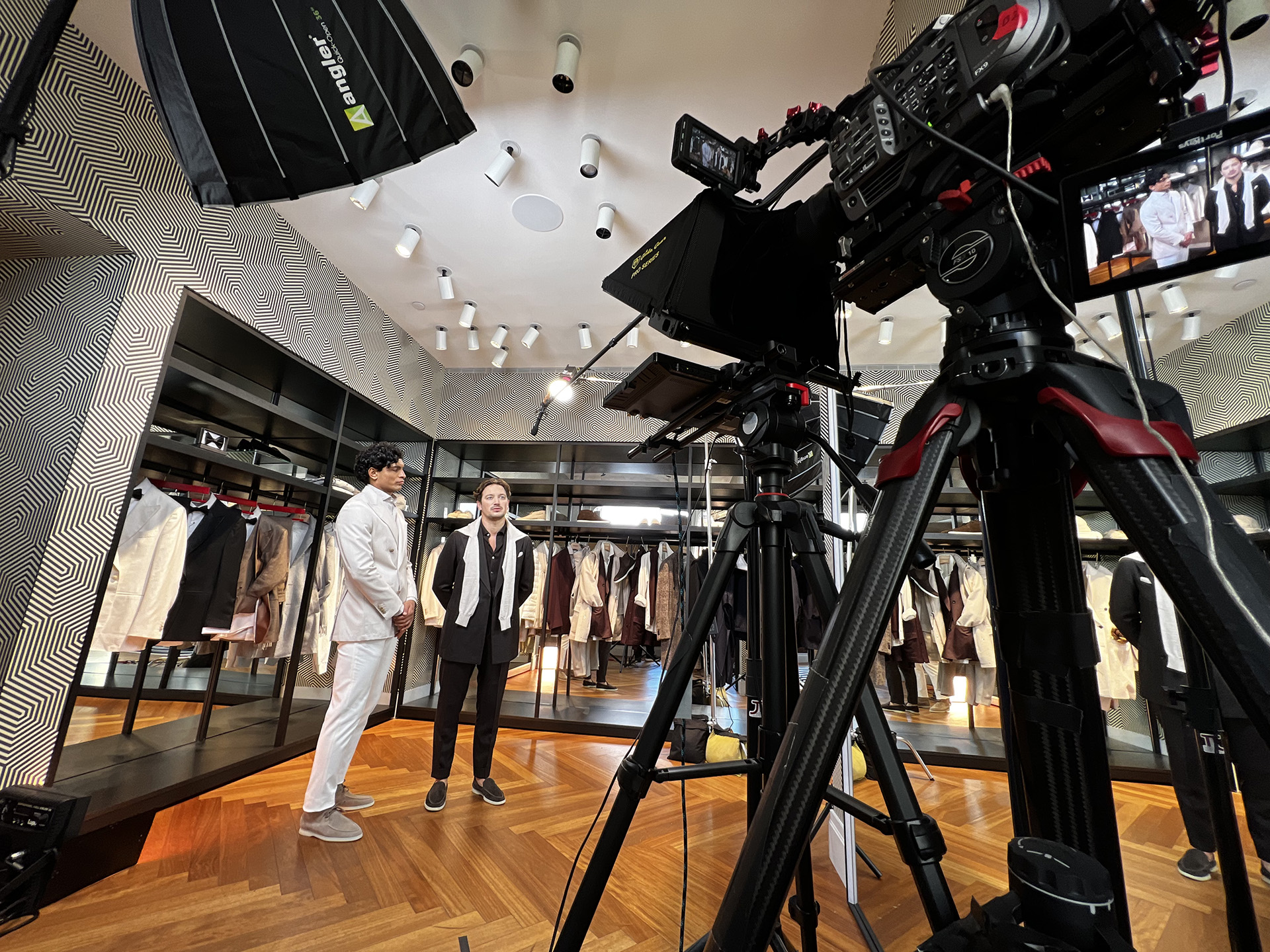
Clients often ask us for a description of the video production process, so we put together this helpful overview.
It contains the main stages of making high-quality commercials, corporate videos, and brand videos.
We’ll delve deep into each stage, explaining what they entail, sharing our expertise, and highlighting some tips and tricks to get you started.
Keep in mind: each project is different, so not every step outlined is always required. Many projects also have unique steps that are not listed here. And client input and approval are built into every relevant step.
For info specifically about video marketing, check out our ultimate guide to the video marketing process.
What Are the 3 Stages of Video Production?
-
- Develop the video concept
- Write the script or treatment
- Design the storyboards
- Finalize the budget
- Hire the cast and crew
- Plan the shoot day logistics
-
- Creative team arrives on set
- Dress set
- Place lights and camera
- Rehearse
- 3… 2…1 Action!
- Film until project wrap
-
- Refine the story in the edit
- Add music and sound effects
- Create motion graphics
- Add special effects
- Color-correct the footage
- Get final approval
- Distribute the video!
What is Pre-Production?

Pre-production encompasses everything from the germination of the idea to the coordination of shoot day logistics. It typically lasts between a couple of weeks for a simple corporate project to a couple of months for a more ambitious video. Since filmmaking is complex and detail-oriented, the pre-production phase is vital to making sure everything goes smoothly, saving you time and money.
What are your objectives?
Before you can start planning a video, you need a concept. To get started, discuss your goals with your team. What message are you trying to communicate? What audience are you trying to reach? What will the style, content, and length of your video be? Finally, how will you distribute your video?
If you don’t know where to begin, reach out to a professional video production company for a consultation. A creative agency can point you in the right direction and supply plenty of great ideas. They can also give you a better understanding of what is possible within your budget.
Develop a video strategy
Think about how this video fits into your larger video and overall marketing plans. Is it part of a series? Timed with a product launch? Where will the video released? And what will the Return on Investment (ROI) be? How can you best capture your audience, and what trends in filmmaking are worthwhile to utilize? Of course, this can all be discussed with a professional video production company that can manage your entire strategy, ensuring your media plan is modern and your videos have a consistent identity and quality.
How to hire a video production company
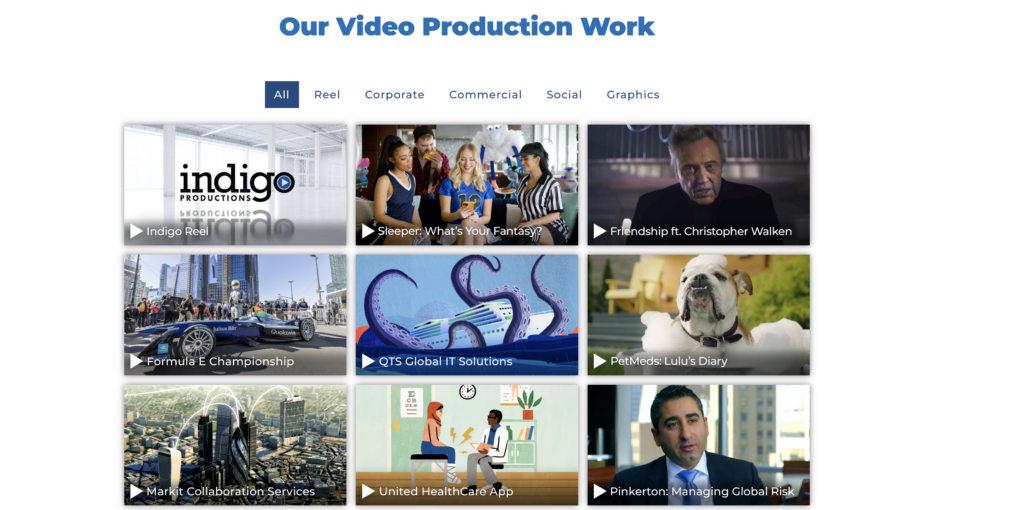
When you’ve found a few good production companies, ask these questions: Do they have a portfolio of relevant videos? Do they have great reviews? Have they worked with major brands? Are they a full-service production company or do they only handle one part of the process? And are they insightful and knowledgeable during meetings?
Once you’ve decided on the key details of your video project, ask them for a quote. We recommend giving them a sense of your ballpark budget because if you’re dealing with a reputable company, they’re going to want to put the dollars on the screen to make the video as great as it can be. Any project can be scaled up or scaled down depending on the client’s financial resources – and really great videos require bigger budgets.
Write a video production brief
To get an accurate estimate, make sure to communicate key details such as deadlines, any motion graphics or animation requirements, and the number of deliverables. It’s also helpful to send over example videos that match the style and production quality you are aiming for. Be skeptical of companies offering a one-size-fits-all solution or quotes that seem too good to be true. Chances are the final results won’t meet expectations.
After you choose a production company, it’s time to sign the contract and start work.
Pre-production overview

When you work with a professional production company, you get expert opinions on the parts of filmmaking you know about, and all the nuanced steps you never considered. At Indigo Productions, we take pride in rolling down our sleeves and planning every little detail during pre-production. Here is just some of the prep work we do:
Write the script
Once we are hired to create a video, we carefully select the right director, writer, and creative team for the project.
Our team researches the client’s brand and product, and assesses competitor content. We then develop and propose ideas for the video based on the client’s brief and our findings.
After the client approves the concept, we create a treatment or script. We also develop a visual language and color palette for the shoot, based on brand guidelines. If the project is interview-focused, we’ll write questions inspired by pre-interview discussions or conversations with subject matter experts.
Draw storyboards
For complicated camera movements, long shots, tricky transitions, or high-budget commercials it is important to create storyboards. Storyboards are sketches of what the final shots will look like and they can be combined with sound effects and VO to create animatics. Storyboards allow us to refine our framing and movement before shoot day, evaluating what works and what doesn’t.
Storyboards are especially important for animated videos. They give a sense of the video before our animators and artists go to work filling out the details of the scenes and movements of the characters. They can reveal if a shot needs more or less time, or if additional shots are needed to add clarity to the action.
Scout locations
If the filming location has not been selected, or if multiple locations are needed, we begin the location scouting process. This requires us to visit the locations in person to ensure they have the right look and will not create problems for production. We send photos of the locations to the client along with our recommendations. We also provide a certificate of insurance, which is almost always required.
Cast the actors
When professional actors are needed, either for the shoot or to provide voice-over, we hold auditions and reach out to the many agencies with which we have great relationships. We also negotiate talent contracts, releases, and usage rights on our client’s behalf. If necessary, we schedule rehearsals.
Finalize the necessary video equipment
We finalize the technical specifications of the deliverables including resolution, frame rate, and aspect ratio. We usually have all the crew and equipment we need in-house but depending on the scale of the shoot we may need to rent out specialized equipment such as specific lenses, lights, and drones, or hire additional crew members such as wardrobe, makeup, production designers, grip and electric, and production assistants. On projects with large crews, we hire trusted vendors to supply food and transportation. When relevant, we ensure we are meeting union guidelines.
As part of our final preparations, we procure hard drives to store and backup media. We also brief our post-production team on the shoot details and coordinate the delivery of the footage.
Schedule the shoot
We schedule final meetings with the crew, client, and talent to make sure everyone is aligned, and send out call sheets for shoot day. In addition, we create a schedule and shot list carefully designed for the most efficient day.
These are a few of the steps that go into pre-production. Depending on the requirements of the shoot there can be countless more, large and small. While pre-production may seem daunting to the uninitiated, we do this every day and handle all the details to ensure a smooth and stress-free shoot.
What Is Production?
Production is the filming process. Actors and talent arrive on set, the crew handles setup and lighting, the camera rolls, and the director yells, “Action!” One exception is animation, where production usually occurs on computers.
What is the client’s role during production?
The production itself should be fun and educational for clients. Sit back, relax, and enjoy the magic of filmmaking. You’ll be given a monitor to view the shots and headphones to listen to the audio. Our crew will check in with you to approve important decisions, but if you see something that feels off, bring it to the producer’s attention right away.
These days, clients don’t even need to be on set. If you prefer, we can send you a live feed of the shoot so you can see and hear everything remotely.
Set up the lights and cameras
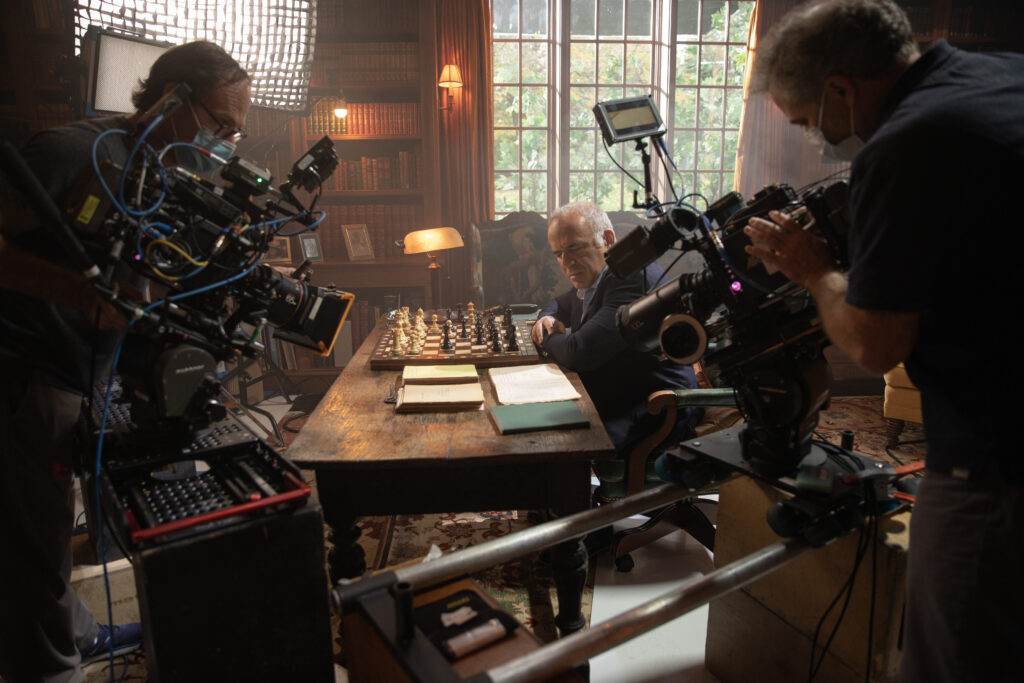
On the day of production, the crew arrives on location two hours or more before the first shot is scheduled. Once they get access to the location, they unload their equipment, unpack, and set up. There can be a significant amount of equipment so this can take time, and a separate area may be needed for storage.
The crew gets the first shot ready. This includes moving furniture, positioning props, setting up lights, cameras, and microphones, loading the teleprompter with the script, and fine-tuning the framing with a stand-in. Meanwhile, the on-camera talent goes to makeup and wardrobe to get ready.
Dress the set
For larger shoots, it may take hours to get the set camera ready. Whether it’s a U-Haul bringing period-accurate furniture, or a team of artisans putting up wallpaper, building facades, and painting props, sets can feel a bit like a miniature construction site. When dressing the set is particularly involved, a location may be rented out for both the shoot day and the day before the shoot, minimizing friction between the art team and crew.
Rehearse
Rehearsals can occur well in advance of the shoot, but it’s often simpler to hold them the day of. Talent will already have this day freed up and the layout of the set will be clear. Before hitting record, the director walks the actors through the scene, establishing blocking (where the actors will go) and performance. Rehearsal isn’t only for the actors, the camera and boom operators, as well as other crew members, practice their maneuvers to nail the perfect shot.
Directing
The director and crew talk through the scene with the talent and film multiple takes, giving notes after each one. The crew works hard to create a comfortable and enjoyable environment for the on-screen talent. And no talking when the camera rolls!
When a new angle needs to be shot or a new location needs to be filmed, there’s another period of setup. This downtime is a great opportunity for the lead creatives to discuss the shoot and any adjustments they’d like to make. There will also be a meal break or two scheduled, depending on the length of the shoot and time of day.
Capture Broll
Broll is additional footage used to supplement the main content of a video. It can be used to demonstrate key points, improve video pacing, and cover up stumbles. Even if a video might not need broll, it is a good idea to capture some, either before the main shoot, after the talent wraps, or in a block of time dedicated to shooting broll with talent. Contemporary broll is frequently shot with gimbal stabilizers. Gimbals smooth out the shakes that come when operating a camera, allowing for gliding shots that feel crane-operated.
Media Backup
As the shoot progresses, the cards fill up with media. A crew member, usually the digital imaging technician (DIT), continuously backs up and organizes the footage for the editor. The DIT can also play back key takes for the director and the client.
Once all the shots for the day are completed, the crew packs up their equipment and leaves the location in the same condition – or better – than they found it.
What is Post-Production?
Post-production is where all the raw footage is transformed into a finished product. On simple projects – especially for social media – editing might be completed the same day. But on larger projects, post-production can take weeks or even months to complete.
As the client you’ll review cuts, giving general and specific notes. You may be asked to make creative decisions such as selecting between different options for music, stock footage, and graphics. For interview-based projects, you might be given a transcript so you can select the most important soundbites.
After the key decisions are made and you are happy with the edit, you sign off on the final cut and upload the video to your chosen platforms and distribution services. Many production companies handle distribution, so if this is a service you need please ask.
Organize Your Footage
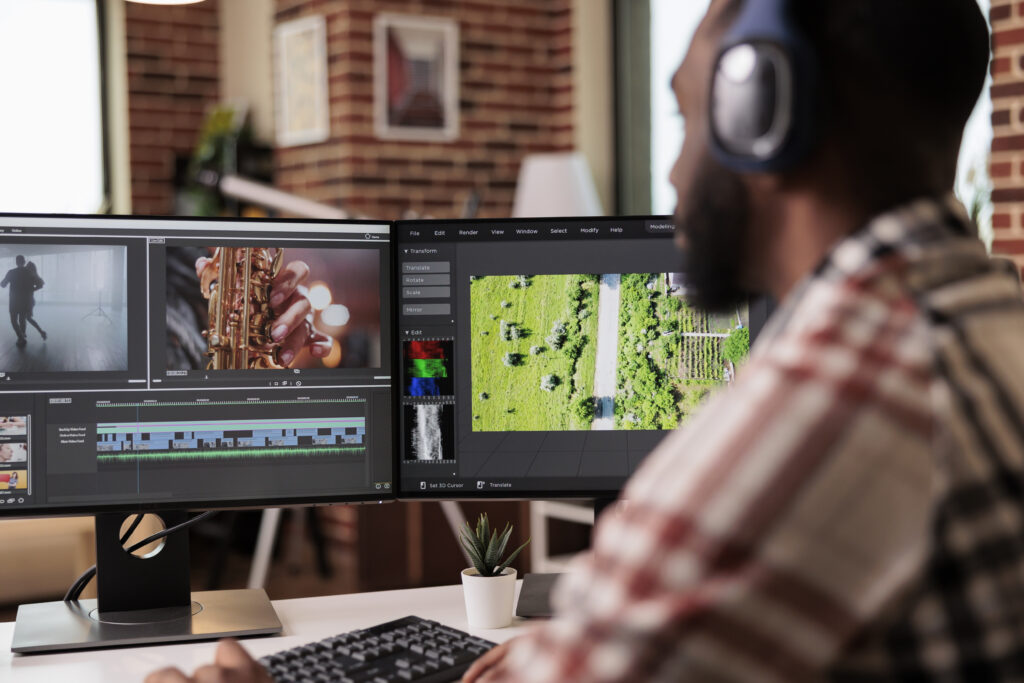
We make the post-production process simple for the client, but the edits the client sees are the result of many days of hard work by talented technicians and artists.
First, the footage is transferred and ingested into the editing software. This can include transcoding the footage into more manageable formats and transforming the image from the RAW camera data into images that look more natural.
The editors review and organize the footage for efficient editing. If transcripts are needed they are sent to the client.
Create the Rough Cut
The initial stage of the edit is the assembly or rough cut. This cut contains placeholder graphics and sound, and the flow of the video might be choppy. But this stage is essential for shaping the story and figuring out what works.
Once the client approves the rough cut, it’s time for the editors to make the story sing. They do this through the use of transitions, timing, visual effects, and sound. After each pass, they’ll send the cut to the client to review and approve.
Create the Fine Cut
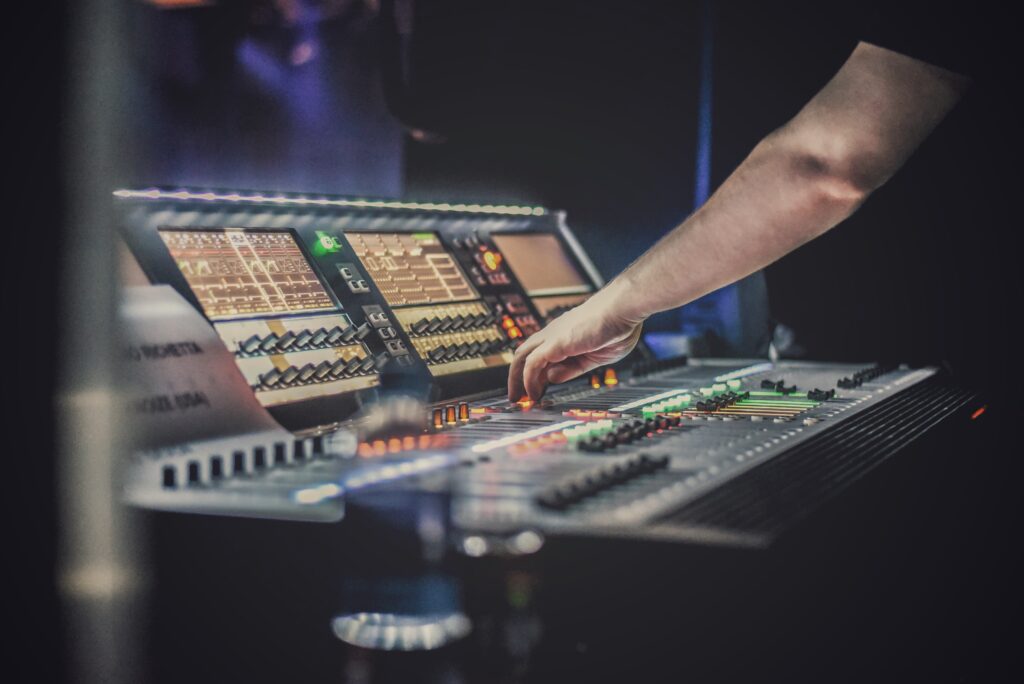
At this point, editors also work to finalize the music. We have the rights to numerous music databases, or we can provide a composer to develop an original music score. If stock footage is needed, we provide a wide selection to choose from. Meanwhile, motion graphics artists work on custom graphics and audition the initial versions in the new cuts.
After a few more rounds of editing, a polished, near-final edit known as a ‘fine cut’ is submitted. Then, at last, we have ‘picture lock.’ This usually means that no more edits are made to the content of the video.
Add graphics, special effects, and finishing touches
But that doesn’t mean the work is done! With the timing set in place, sound mixers and designers start their work, adding new sonic dimensions to the video. The final voiceover is recorded and integrated. And graphics get one last pass. A colorist will fine-tune the shots to make them look their best. Special effects, such as replacing green screen footage and rotoscoping are also completed.
Create Captions
These days, audiences expect to see captions on their social media videos. TikTok videos almost always have text highlighting key phrases, and YouTube videos let you toggle captions on and off. That’s because videos are increasingly viewed on the go. Viewers can’t always hear the videos well or may have the sound off entirely.
At Indigo Productions, we use cutting-edge AI tools to auto-generate incredibly accurate captions. We proofread and correct the captions, and format them so they look great and fit the vibe of your video. We can also create .srt files, which contain all the caption information and can be uploaded to most video apps.
Create crops and alternate deliverables
If we are delivering your video to different platforms, we might have multiple delivery specs. Depending on where the video will air, we may create a longer or shorter cut, and export in varying resolutions, codecs, and even aspect ratios.
Vertical videos have become the norm on social media apps. It’s super easy to create a vertical video if you film all the content vertically like most iPhone users do. But professional videos are almost always shot horizontally. To best take advantage of traditional and mobile distribution platforms, we often create a mobile-specific deliverable. We crop into the horizontal video, highlighting the most important parts of the shot, and add keyframes, panning the video to keep the subject in view. It’s more work, but the results speak for themselves!
Distribute and promote
The final cuts are reviewed, approved, and exported with the correct specs. The videos are uploaded to the various platforms and tagged with metadata and descriptions that drive search results. It’s important to have an attention-grabbing thumbnail. Once the video is uploaded, it’s quality-checked one final time to make sure nothing is off compared to the local export. If everything looks good, the video is published. And at last, whether on television or social media the video makes its way to its audience!